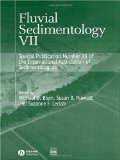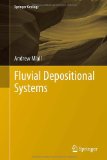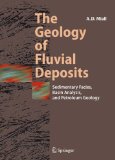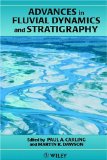Fluvial sedimentology
- 10th International Conference on Fluvial Sedimentology - 314-19 July 2013, Leeds, United Kingdom
- 3D Modelling and Simulation of Multi-Scale Heterogeneities in Fluvial Reservoir Analogues, Lourinha Fm., Portugal: From Virtual Outcrops to Process-oriented Models

- 3D Modeling of Coarse Fluvial Sediments Based on Mobile Laser Scanning Data

- A New Sequence Stratigraphic Framework of Terrestrial Fluvial

- A Review of Some Fluvial Styles

- Aberdeen University - Fluvial Systems Research Group
- Acquisition, 3-D Display And Interpretation Of GPR Data In Fluvial Sedimentology

- Alteration of detrital Fe-Ti oxides in Miocene fluvial deposits, central Jutland, Denmark

- Architectural-Element Analysis: A New Method of Facies Analysis Applied to Fluvial Deposits

- Channel Geomorphology: Fluvial Forms, Processes, and Forest Management Effects

- Channel planform as a non-controlling factor in fluvial sedimentology: the case of the Squamish River floodplain, British Columbia

- Concepts and applications of fluvial sedimentology: Towards interdisciplinary analysis of process and product

- Deltaic clinotherms - Digital data capture, geometries, and reservoir implications

- Diagnostic sedimentary structures of the fluvial-tidal transition zone – Evidence from deposits of the Rhine and Meuse

- Evolution of the Late Neogene and Eopleistocene fluvial system in the foreland of the Sudetes Mountains, SW Poland

- Facies and architectural analysis of fluvial deposits of the Nýřany Member and the Týnec Formation (Westphalian D – Barruelian) in the Kladno-Rakovník and Pilsen basins

- Fluvial-estuarine transitions in fluvial-dominant successions; examples from the Lower Pennsylvanian of the Central Appalachian Basin

- Fluvial responses to climate and sea-level change: a review and look forward

- Fluvial Sedimentology and Stratigraphy of the Late Jurassic–Early Cretaceous Monteith Formation

- Fluvial Sediments - A Summary of Source, Transportation Deposition, and Measurement of Sediment Discharge

- Geo-modelling of Small Scale Fluvial Bedform Architecture from the Lourinha Fm., Lusitanian Basin, Portugal

- Geomorphic and sedimentary response of rivers to tectonic deformation: a brief review and critique of a tool for recognizing subtle epeirogenic deformation in modern and ancient settings

- Geomorphology and stratigraphy of inset fluvial deposits along the Rio Grande valley in the central Albuquerque Basin, New Mexico

- Jurassic-Cretaceous fluvial channel and floodplain deposits along the Karak-Kuantan Highway, central Pahang (Peninsular Malaysia)

- Laser scanning applications in fluvial studies

- Leeds University - Fluvial & Eolian Research Group
- Luminescence dating of fluvial deposits: applications to geomorphic, palaeoseismic and archaeological research

- Migration structures of meandering channels

- Morphologic and facies trends through the fluvial–marine transition in tide-dominated depositional systems: A schematic framework for environmental and sequence-stratigraphic interpretation

- Neogene fluvial and nearshore marine deposits of the Salten section, central Jylland, Denmark

- Reservoir modelling of fluvial systems: An example from the Gulf of Thailand

- Sand- and mud-filled fluvial palaeochannels in the Wielkopolska Member of Neogene Poznań Formation, central Poland

- Sedimentology and Geomodelling of Small Scale Fluvial Architecture from the Lourinha Fm., Central Portugal

- Sedimentology of an intra-montane rift-controlled fluvial dominated succession: The Upper Triassic Oukaimeden Sandstone Formation, Central High Atlas, Morocco

- Sedimentology of Beaufort-Molteno Karoo fluvial strata in the Tuli Basin, South Africa

- Subsurface Lithofacies Analysis of the Fluvial Early Permian Warchha Sandstone, Potwar Basin, Pakistan

- Turku University - Fluvial Research Group
| Fluvial Sedimentology VII: (Special Publication 35 of the IAS) The 29 papers in this volume reflect the topical and geographic diversity of exciting research conducted by fluvial sedimentologists at the beginning of the 21st century. Themes represented in this volume include (a) flow, sediment transport, and bedform dynamics, (b) characteristics of modern fluvial landforms, environments and systems, (c) physical analogue and numerical modeling of fluvial systems, (d) the responses of Quaternary fluvial systems to climate change, active tectonics, and/or sea-level change, and (e) characteristics of pre-Quaternary fluvial deposits and evolution of pre-Quaternary fluvial systems. |
|
| Fluvial Depositional Systems The book summarizes methods of mapping and interpretation of fluvial depositional systems, with a detailed treatment of the tectonic, climatic and eustatic controls on fluvial depositional processes. It focuses on the preserved, ancient depositional record and emphasizes large-scale (basin-scale) depositional processes. Tectonic and climatic controls of fluvial sedimentation and the effects of base-level change on sequence architecture are discussed. Profusely illustrated and with an extensive reference to the recent literature, this book will be welcomed by the student and professional geologist alike. |
|
| The Geology of Fluvial Deposits: Sedimentary Facies, Basin Analysis, and Petroleum Geology The Geology of Fluvial Deposits represents the first published synthesis of research on the sedimentary geology of fluvial deposits. It sets out in detail the methods for the field and subsurface study of these sediments, and provides geologists with detailed descriptions of the building blocks of fluvial stratigraphic units, from lithofacies through architectural elements and depositional systems to large-scale stratigraphic sequences and basin-fill complexes. The book contains a new classification of oil and gas fields in fluvial reservoirs, with descriptions of selected case examples. Profusely illustrated and with an extensive reference to the recent literature this textbook will be welcomed by the student and professional alike. |
|
| Advances in Fluvial Dynamics and Stratigraphy Developments in the modelling of sediment transport in rivers and the interactions with the river-bed have been remarkable over the last two decades. This progress has increased the understanding of the nature of turbulence, and the ability to replicate mathematically simple flow-particle interactions which can be observed experimentally. In addition, quite elegant models of stratigraphic complexes have evolved because of the growing computational power available to scientists. As always, additional knowledge has raised even more intriguing questions and the quest for explanation of phenomena has led to increased specialisation. Therefore, there are few fluid dynamicists or sedimentologists who can successfully span the two disciplines. The intention of this book is to assist various specialists on keeping abreast of current developments in related areas. The book initially focuses on hydrodynamics of turbulent flow, followed by basic two and three-dimensional flow through straight and curved channels and the flow over bed topography. This is then followed by a consideration of initial motion, sediment transport and particle sorting. The potential for modelling fluidsediment interactions is provided at the end of the first section. Linking chapters then follow, considering the preservation potential of fluvial bedforms in the stratigraphic record and the basic variety of channel morphology recognised in sedimentary studies. Subsequent chapters consider reconstructing hydraulic process and fluvial morphology from stratigraphy; the influence of bedform and depositional controls on packing of economically important sedimentary rocks; and recent advances in modelling subsurface fluvial stratigraphy. A final chapter provides a brief view of future perspectives. The objective of this volume is to review recent advances made by geologists and hydrodynamicists in an accessible manner and to promote an increased and fruitful dialogue between sedimentary geologists, geomorphologists and hydrodynamicists. |



